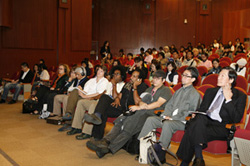

 The 2006 Taipei Biennial International Forum brings together more than a dozen international art experts, including several of the participating artists, to discuss and explore questions related to the state of producing and presenting art today. The Forum program, which will combine individual presentations and panel discussions, will last a full day.
The 2006 Taipei Biennial International Forum brings together more than a dozen international art experts, including several of the participating artists, to discuss and explore questions related to the state of producing and presenting art today. The Forum program, which will combine individual presentations and panel discussions, will last a full day.
In preparing this program, it was suggested that far too many international panel discussions about contemporary art concoct inflated premises for discussion that do not necessarily reflect the specific interests of the invited participants. In addition, the theme on which the 2006 Taipei Biennial has been developed, Dirty Yoga, and the many new or borrowed works on view, might themselves provide sufficient room for reflection on the part of the individual panelists.
For these reasons, two of the three Forum panels have been organized according to no subject beyond their participants’ respective professional categories: artists and curators. Working from the added assumption that these are colleagues who will always find something to talk about to one another if given an opportunity, the individual speakers have also not been asked to prepare a formal presentation. Consequently, the responsibility of leading the discussion falls even more heavily on the moderators, who also happen to be the co-curators of the 2006 Taipei Biennial.
The third panel, Collecting and Commissioning, is very much an exercise in pragmatics. With growing media and public attention focused on the milieu in which contemporary artworks are bought and sold, there has been a corresponding tendency to invent new strategies for how institutions and individuals collect. A new interest in commissioning artworks appears to be especially suited for artists who use digital media, which can be extremely labor-intensive and often requires significant production costs.
If the purpose of a Biennial is to bring together artists and works from different parts of the world for the purpose of sharing in the experience of new art, then a Forum’s goal should be to stimulate a spoken discourse between the people who have traveled long distances to participate, and those who will remain to absorb the Biennial after the visitors have gone. It is hoped that transparency of this year’s Forum will encourage an exchange that will be fruitful and engaging for all.
-Dan Cameron
Departing from Sao Paulo, flying past New York, Los Angeles, Stockholm, Berlin, London, Madrid, Milan, Bombay, Delhi, Yogyakarta, Guangzhou, Beijing, Seoul, Tokyo, and finally arriving in Taipei - it is easy to take a trip around the world in one week. This is the age we are living in. If we take into account the ubiquitous cyberspace, there is almost zero distance in terms of communication between people in different parts of the world. But is it the same world we see from Yogyakarta, New York and Taipei?
In the case of Taipei, it is now drowning in the wave of the idea of internationalization, which is hard to define. Apart from the problem of criteria, there is also the problem of cultural identity. Taipei is caught in between different worlds, even though this may not be apparent from its urban landscape. The bilateral exchange (capital and labour) between the countries in the centre and periphery of the world has produced the strange values of this age. The phenomenon of globalization has clouded people's judgment about where they stand. Although ambivalent intermediate spaces abound, we only see the superficial single set of values that is being controlled.
The artists and guests invited by the 2006 Taipei Biennial are now making their way to Taipei from all over the world. With their own expertise, they are engaged in the communication of cultural ideas in different globalized locations. They are like explorers searching for various kinds of possible positions in the context of globalization pervaded with confusing values. The whole venture resembles a long-term utopian dream, which might or might not be realized, but a constant collision of ideas and thoughts is taking place. This is precisely the basic intent of the "2006 Taipei Biennial: Dirty Yoga": searching for possibilities and thinking about our situation.
- Jun-jieh Wang